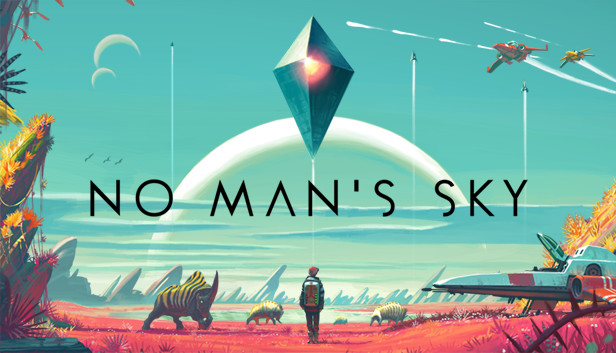No Man’s Sky and the Concept of Om
By Darth_Navster 16 Comments

As a child, I was brought up in the Hindu faith. This religion, one of the oldest in the world and still widely practiced, is often misunderstood by outsiders. While Hindu concepts like yoga and the pantheon of gods have penetrated into Western culture, the actual practices and beliefs of Hinduism remain foggy at best. There’s a good reason for this. Given Hinduism’s ancient origins and the lack of a hierarchy, the religion has been interpreted in countless ways by a great many people. Even the so-called central tomes of Hindu belief, the Mahabharata and the Ramayana, are rarely read in full by adherents. The result of this history is that Hinduism tends to be a faith that is passed down verbally through the generations, and often you will see individual families or communities practicing their own form of the religion. Such was the case with my upbringing, in which I learned about Hinduism through stories that my mother and grandfather would tell me. But this was not enough to sustain my belief, and I found the certainty of science and civic institutions to be more comforting than old epics about Shiva and Lakshmi. I eventually became an Atheist, which remains my spiritual affiliation to this day.
No Man’s Sky has seemingly set the gaming world on fire with its recent release. The game, a sort of epic survival adventure, has players exploring planets for resources and treasure in order to continue their journey to discover more uncharted worlds. There are goals for players that prefer structure, but there’s just as much joy in staking out unguided and discovering wonders off the beaten path. There’s a breathtaking sense of scale to No Man’s Sky, one where it will take several real world minutes to reach the next planet or star system despite your spaceship travelling at fractions of light speed. Even the smallest planets and moons feel unfathomably massive when you pick a landing spot. What was a pale orb merely minutes ago now feels like the biggest thing ever conceived, of which you will only ever explore an infinitesimally small piece. This scale remains a constant reminder that you are the exact opposite of the hero of this story. Instead, you may as well be a dust mote on an elephant’s back, an insignificant little thing that will make no impact with your actions.

For all the variances in Hindu beliefs, there are a few things that remain constant. Primary among these constants is "Om”. Om is many things; it’s a symbol commonly used to represent Hinduism analogous to Christianity’s Crucifix or Judaism's Star of David, it’s a mantra for focusing in meditative activities, and it’s a concept for what binds and governs the universe. It’s that third usage of Om that’s always spoke the most to me, even as I moved away from Hinduism as a whole. Om is meant to represent the highest plane of reality, of truth, of the universe as it is. Looking at it that way, aren’t the laws of physics merely a scientific description of Om? Of course, there are certain interpretations of Om that ascribe more fantastical elements to it, such as the concepts of souls and reincarnation. But at it’s most basic level, isn’t it just a flowery way of saying that our reality follows certain rules? Doesn’t it simply acknowledge our very human desire for connection and meaning in a cold, vast, and indifferent universe?
There’s been much discussion in the lead-up to the release of No Man’s Sky regarding its development process. In an industry where blockbuster games require hundreds of people working across continents, Hello Games managed to make their opus with about 15 people in a single studio. In an era where blockbuster games can be up to 100 gigabytes in size, No Man’s Sky installs at a paltry 6 gigabytes. In a market that demands dense lore, bespoke set pieces, and ever increasing feature lists, the game barely has a structure. The story of how this was possible has come down to two words: procedural generation. Rather than create an entire galaxy from scratch, the world of No Man’s Sky is created on the fly by programmed rules embedded in its code. In effect, the creation of this artificial galaxy is not all that different from the scientific and mythological explanations for the creation of our own universe. The code is, in essence, the Om of No Man’s Sky.
I can’t but help feel a strong spiritual streak running through No Man’s Sky. The considered pace of the gameplay, the reflective soundtrack, and the bits of story and lore, all emphasize the quiet wonder of creation. Of how between the numbers and science emerges something vast, beautiful, and seemingly unfathomable. Of how by exploring an insignificant part of it can feel like an act of worship. By mining elements, by creating technology, by documenting life, the game pushes us to reckon existence as a concept. We are compelled to think about the hows and whys of our universe on its most basic level, and by extension, to consider the hows and whys of our own spiritual frameworks.
Much has been discussed of whether No Man’s Sky is a “good” or “bad” game. Certainly, on typical rubrics there isn’t much present to call it all that compelling. The gameplay loop is repetitive and the planets aren’t as varied as people like. However, the game succeeds in using interactivity as a language to meditate on the concepts of creation, reality, spirituality, and science. It has encouraged me to consider parts of my spirituality I had not thought about in a long time, and has given me a better understanding of the faith I grew up in. It doesn’t excuse the technical and design shortcomings of No Man’s Sky, but perhaps the game was never concerned with simply being “good”. Maybe it’s focused on something greater.